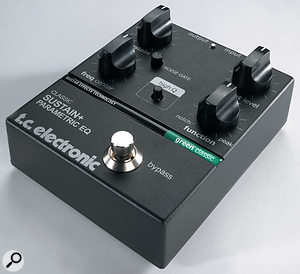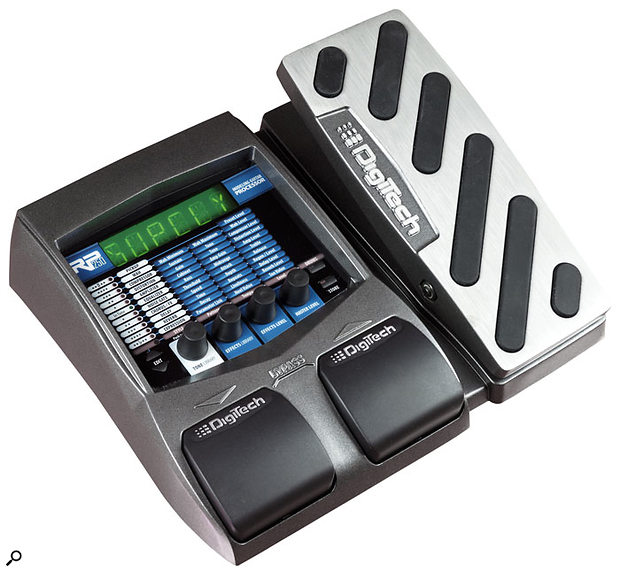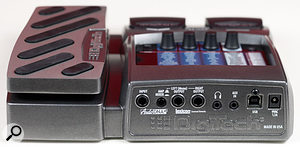The RP250 is the middle model in Digitech's new range of three digital guitar preamps, all of which take advantage of the company's newly developed Audio DNA2 chips. These apparently took two years to develop and offer four times the power of the previous generation of this device. They are the same chips as used in the Artist Series of pedals, and I have no doubt that some of what was learned in the development of the Artist Series has found its way into these products. Having more processing power to play with means the designers can not only offer more simultaneous processes, but they can also improve on such things as picking dynamics and the finer nuances of guitar tone.
The problem with many engineer-led products is that they end up being very complicated to use, so I'm glad to say at the outset that Digitech haven't fallen into that trap. In fact they've made getting the right sound very easy by offering three levels of complexity. The first level is to go through the presets, find something you like and then play. Going slightly deeper you can call up amp and effects settings from the internal library and combine these building blocks to come up with your ideal tone or something close enough to tweak. Those wishing to go deeper still can then adjust the controls within all the various sections to arrive at their own amp, speaker and effect settings. Whichever way you go, there's nothing too difficult. Nonetheless, there's rather more to this innocuous-looking little floor unit than amp and effect modelling.
Look a little closer and you'll discover that the RP250 features a 60-pattern drum machine for you to jam along with, and there's also a 2-in, 2-out USB audio interface, that allows you to record 24-bit sounds straight from the RP250 into your favourite audio software. This same USB port also allows you to use an on-screen editor to create and archive your own patches — X-Edit is a free download from the Digitech website, where you can also find out how to exchange patches with other members of the on-line guitar playing community. Unfortunately, at the time of review, only the Windows version of the support software was available, so I wasn't able to try this on my Apple Mac.
The RP250 is built into a chunky cast-metal housing that also includes two footswitches and an expression pedal. It uses a six-character LED display for editing, which also displays a cryptic version of patch names. The first of the four front panel knobs in the recessed editing area incorporates a push switch for turning effects on or off, patch naming, or for accessing the patch libraries. On the rear panel are the high impedance guitar input, two quarter-inch output jacks for mono or stereo operation, and a 3.5mm stereo phones jack. There's also a 3.5mm stereo Aux input jack, so you can play along with your MP3 or CD player, a standard USB port and a power jack for hooking up the included mains power adaptor. I really hate these things on any unit intended for live performance, as the connectors simply aren't robust enough to stand up to the inevitable abuse. Also on the rear panel is a button for selecting whether you wish to feed the RP250 into a mixer for recording (or live DI use), or into the front of a guitar combo/amp. The mixer output includes speaker simulation to make the DI'd result sound like a miked speaker cabinet, whereas the combo output relies on the guitar speaker to shape the high end. Getting the right sound from a guitar amp or combo relies on setting a fairly clean, neutral sound — otherwise you'll have both the RP250 and the amp competing to shape your tone!
On this model, the two pedals function as patch up or down buttons in the normal play mode, and you can press both together to bypass the unit. You have to be a bit careful doing this, though, because if you don't hit both pedals at the same time, the unit will scroll rapidly through its presets, making it easy to get lost. You can also press and hold both switches to engage the on-board tuner, but the same caveat about hitting the switches together applies. The expression pedal, which is to the right of the footswitches, can be assigned to volume, wah, whammy (Digitech's own dynamic pitch changing effect) or pretty much any other effect parameter you wish to control. When the drums are active, hitting Bypass also kills the drum sound.
To edit or create patches, you must start from an existing patch, calling up new amp or effect settings from the library or dialling these in from scratch. A pair of up/down buttons to the left of the rotary controls moves up or down, through 12 rows of edit functions associated with the amp and pedal types. An LED at the start of each row denotes which is active (when not in edit mode, these same LEDs light to show which modules are active). Depending on the row selected, the knobs control different functions, as itemised in the parameter matrix printed above them, and when controlling effects, they tend to control the same simple parameters you'd expect on a stomp-box equivalent. The lowest row selects the drum pattern style, pattern, tempo and level, while a button just below the end of this row switches the drum pattern generator on or off.
The processing chain starts with something we've seen in earlier Digitech products: a specialist equaliser that can make a single coil pickup sound like a humbucker, or vice-versa. The signal then passes through blocks for wah, compression, distortion, amp type, EQ, noise gate, chorus/FX, delay, reverb and the expression pedal. Most of the effects are what you'd expect to find in any well-appointed guitar multi-effects unit, but you also get the full range of Whammy pitch bend pedal effects, rotary speaker, vowel type wah effects and slow attack envelopes. There are also pitch and octave effects, plus reverbs by Lexicon (which, like Digitech, is a Harman company) and a nice model of an EMT plate reverb, as well as all manner of digital, analogue and tape delays, with a maximum delay time of five seconds. All the usual modulation effects are available, as well as few less obvious ones, including sample-and-hold-style filter effects. A number of established pedal distortion units are modelled, and I was particularly impressed by one that was obviously based on the legendary Ibanez Tube Screamer.
In all, there are 21 amp models if you include the acoustic emulation, and 54 effect models. The library section comes with 30 amp setups and 30 effects setups and, once an amp is selected, the user can switch between 14 different cabinet models. To get you started there are 60 factory presets, with space to store a further 60 of your own user presets and, when you come to create your own sounds, up to 11 effects can be chained together, which can include a noise gate to keep down hiss between notes.
Accessing and adjusting patches is, in fact, trivially easy, but with so much scope available you do need to have some idea of what you're trying to achieve. Even if you're not a fan of reverb, most guitar sounds will come over as unnaturally dry if you don't add at least a hint of reverb or delay in a recording environment, but for live performance you can treat the unit just as you would any other effects pedal board, with or without the amp simulation turned on. As intimated earlier, if you intend to use the amp modelling, your stage amp needs to be set clean and as neutral as possible.
As a recording solution, the RP250 is capable of producing some highly polished guitar sounds, both clean and overdriven, but when it comes to subtle blues tones, with just a hint of overdrive, you have to work fairly hard at the programming. I don't think there's really much improvement over the earlier Genesys 3 in this area. Where the unit does score, is in its ability to combine so many great amp models and effects, enabling you to go far beyond the commonplace, into more abstract areas. I feel this is important because, much as I love classic guitar tones, the instrument isn't going to evolve if everyone uses boxes that only emulate what has gone before.
As with every single piece of guitar modelling hardware or software that I've ever tried, the presets are seldom useful just as they come, because every guitar and every player is different. If you're prepared to put in a bit of work, you can coax some very realistic amp sounds out of the unit, just don't expect the presets to do exactly as they say on the packet regardless of what guitar you plug in or what playing style you adopt.
This range of floor units is very attractive from a number of angles, not least the fact that the unit is ergonomically well designed, with the knobs recessed out of harms way in a robust metal chassis. The pedal has a good positive feel to it — and actually controls the whammy effect a lot more smoothly than my own dedicated whammy pedal, which costs almost as much as the RP250 on its own.
For me, the least satisfactory aspect of these pedals is their use via guitar amps, because, even if the amp EQ is set to flat, there's no guarantee that the frequency response is actually anywhere close to flat. This isn't a criticism of Digitech's design as it applies equally to all devices of this type. To get the best subjective result, you'll need to experiment with the amp tone controls, and make a note of them for next time. In fact, you may be better off buying one or two medium-sized, powered monitors, and playing the unit through them, using the output setting for connecting to a mixer.
The quality of the effects is excellent, as you'd expect from a company that started life specialising in effects. I don't feel the amp modelling is subjectively very different from what the already excellent Genesys 3 offered, but it is perfectly able to create satisfying emulations of classic amps, and offers a few less obvious sounds, providing you're prepared to spend a few minutes fine-tuning the patches to suit your guitar and playing style. Having a drum machine to play along to isn't a new idea by any means, but it makes practice a lot more fun. Finally, at £149 including VAT, the RP250 is sensibly priced, and having a USB audio interface built-in will be a great bonus for the guitarist who wants to make recordings without spending a lot of extra money on dedicated recording equipment.
SUMMARY
A capable, easy to use multi-FX and amp modelling guitar pedal that doubles up as an audio interface for recording guitarists.
Sound Technology +44 (0)1462 480000.
www.soundtech.co.uk
www.digitech.com
NEWS


 TC Electronic has launched its Classic Pedal Series — reissues of three classic effects pedals from the 1970s, each priced at £194 including VAT.
TC Electronic has launched its Classic Pedal Series — reissues of three classic effects pedals from the 1970s, each priced at £194 including VAT.
TC say the TC XII Phaser is true reproduction of the sought after sound of the original: a clean sounding, versatile phaser, featuring lots of tweaking possibilities. It includes low-frequency oscillation speed controls, width and function controls and a 4-8-12 kHz filter selector, just like the original. It can be used in numerous ways, and is capable of sounds from clean funky chords to overdriven riffs or heavily saturated leads.
The Booster+Distortion is (not surprisingly) both a signal booster and a distortion pedal. It recreates every nuance of the original sound, and features the original Bass and Treble EQ, as well as output level and distortion level knobs. This Classic reissue also features a built-in Noise Gate, to keep hiss under control at high gain settings. It can be used as an 'always on' boost pedal, increasing the output level of the guitar, making the tubes work harder and thus generating more overdrive, and it can also be used as a boost pedal to occasionally highlight a specific solo, lick or melody passage.
The Sustain+Parametric Equalizer is a studio quality compressor, in a pedal. Like the original, it features controls for Frequency, Sustain and Function. It can be used to simply increase or decrease the output signal whenever the signal falls above or below a certain level, but extreme compression can be used as an effect for funk or country playing, giving the sound a special percussive "thud".
TIPS & TRICKS
DIY Guitar Lube
There are several commercial guitar string lubrication products that offer a hi-tech alternative to putting pencil lead in your nut slots or on your bridge saddles to reduce tuning instability problems, but if you don't mind cooking up your own recipe, here's something I tried recently that really works and costs very little.
One of the well known guitar tech solutions is to mix powdered graphite (available from some old-school locksmiths) or sandpapered pencil lead with Vaseline, and that's something you can easily do for yourself. To make using and storing the lubricant easier, I tried melting down the contents of a lip salve stick, mixing it with half a teaspoonful of soft art-pencil lead, which I'd sanded down to a fine powder. I poured it back into the plastic holder and allowed it to set. You can melt the salve (which seems to be similar to Vaseline but a little less runny) in a metal foil pot dipped into boiling water, or held over an electric hob ring. The whole process only takes a minute, as the waxy material melts at a very low temperature, and the result looks something like a black lipstick.
You can apply small amounts to your nut slots, string Ts and saddles, using a wooden cocktail stick, and one tube should last for years. It seems to work as well as any of the commercial products I've tried.


